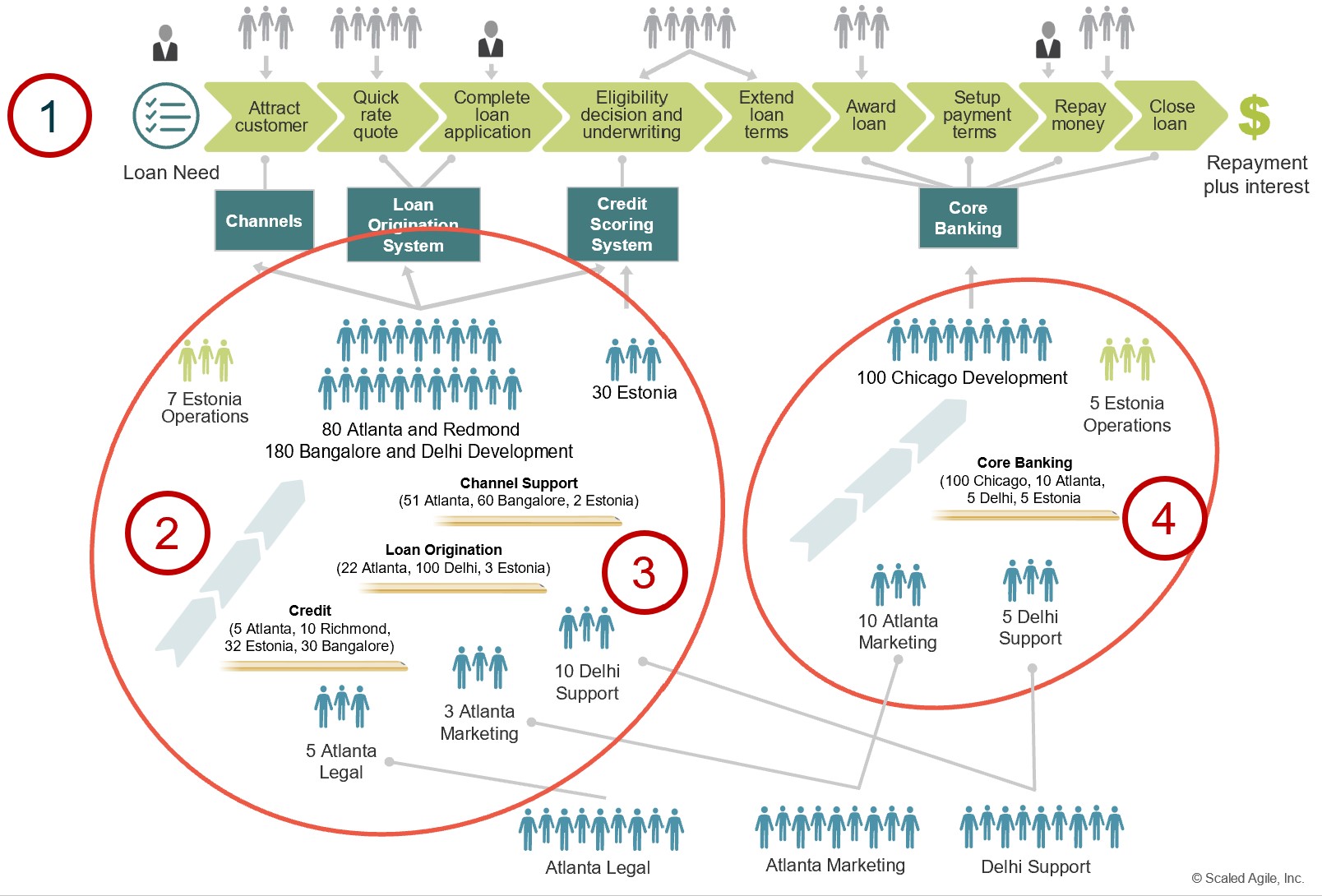When it comes to organizing in SAFe (Scaled Agile Framework), "organizing around value" is a fundamental principle. It emphasizes the importance of structuring an organization's teams, processes and activities in a way that prioritizes and delivers value to customers and stakeholders. In this respect, the principle recognizes that the primary objective of any organization is to deliver valuable products and services that meet the needs and expectations of users.
How does this organization around value manifest itself in the SAFe implementation roadmap? That's what I'd like you to discover here. As a reminder, any organization respecting the SAFe implementation roadmap works on key points in the structure of its organization, these points being, in descending order, OVS, DVS, ART and Agile teams.
It's up to you, but for my part, I always prefer to start with the big picture, as with the SAFe configuration on their home page. Below, I suggest you follow a numbered path through the four stages of defining your organization around value:
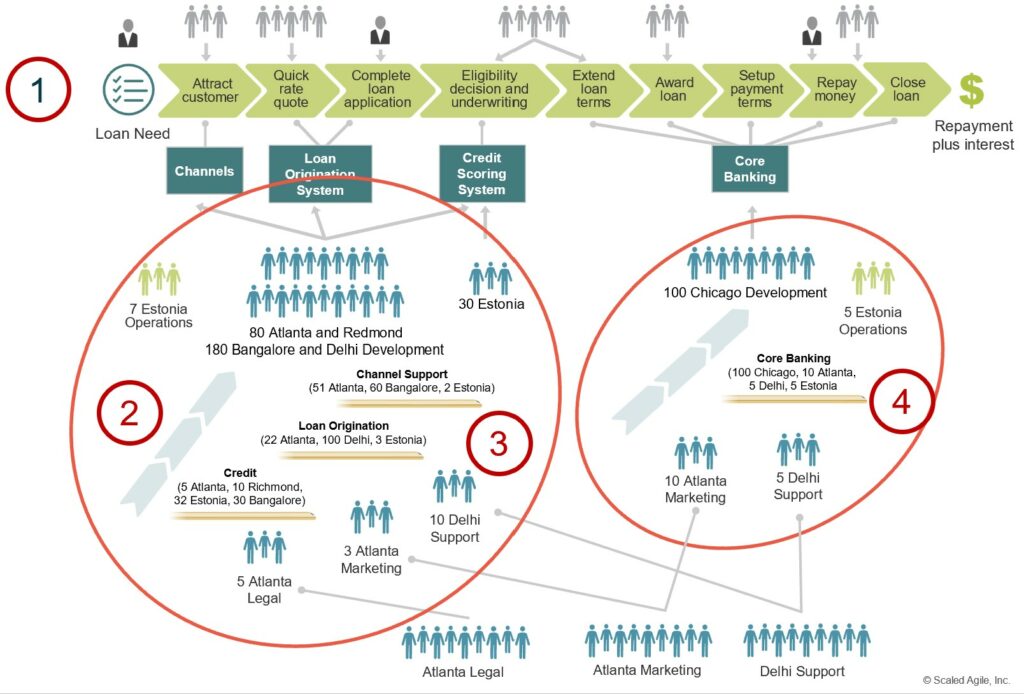
Key concept for SAFe #1: the Operational Value Stream (OVS)
In the Scaled Agile Framework (SAFe), an Operational Value Stream (OVS) represents a sequence of activities, processes and steps that an organization follows to deliver value to its end-users through its operational activities. In effect, the OVS focuses on the ongoing activities required to support, maintain and enhance these solutions once they are in production. In principle, it ensures that delivered solutions continue to deliver value and operate efficiently throughout their lifecycle.
Below is an example of OVS for software product development:

In fact, here we can see the steps required to transform the user requirement "Loan need" into the value of the loan "Loan repayment plus interest", passing through nine intermediate steps such as "Loan application completion" or "Payment deadline configuration".
Implementing SAFe's operational value stream approach helps organizations maintain a balance between innovation and stability, ensuring that their solutions not only meet customer needs at the outset, but also continue to do so over time, promoting long-term success and customer satisfaction.
Key concept for SAFe organization #2: the Development Value Stream (DVS)
The Development Value Stream (DVS) refers to the end-to-end sequence of activities, processes and steps an organization follows to create, develop and deliver valuable solutions to its end-users. It encompasses the entire solution development lifecycle, from ideation and concept to deployment and release, as well as sustainment.
SDV involves cross-functional teams working together to conceptualize, design, build, test and deliver features, enhancements or complete solutions. It includes activities such as backlog refinement, iteration planning, build, validation, integration and release. In this way, organizations can achieve several benefits, including better collaboration, faster time-to-market, higher product quality and better alignment with user needs. This approach helps organizations maintain a constant flow of value creation, while fostering a culture of continuous improvement and adaptability.
The structure of a DVS is shown below:

In summary, the development value stream in SAFe focuses on the processes and practices that enable organizations to efficiently create and deliver valuable solutions in an effective, customer-centric way.
That said, SAFe emphasizes the need to manage development and operational value streams coherently to achieve a holistic approach to creating and sustaining value. However, organizations can identify opportunities for improvement, streamline processes, reduce waste and enhance the overall user experience by understanding and optimizing these value streams.
Key concept for SAFe organization #3: Agile Release Trains (ART)
An Agile Release Train (ART) is a key organizational structure designed to facilitate value creation in a coordinated and synchronized way. An ART represents a team of agile teams, built to last and self-organized. These teams work together to deliver useful solutions through a series of fixed-length iterations, called Planning Interval (PI). Indeed, the ART concept is based on the idea of aligning and integrating the efforts of several agile teams, each contributing to the construction and delivery of part of a larger solution. These teams collaborate closely, sharing information, dependencies and feedback, all with the aim of delivering valuable, functional increments of the solution at the end of each IP.
Here is an ART with fully cross-functional teams:
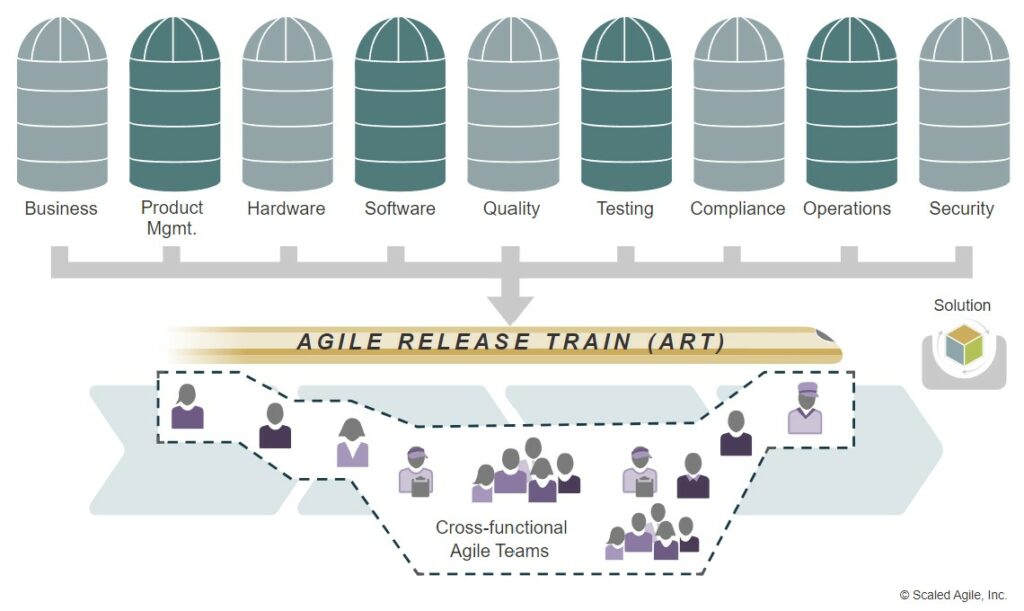
An ART requires between 50 and 125 team members, or around 5 to 12 teams. If less than 50 people, we consider the SAFe framework to be too cumbersome for the organization. Beyond 125 people, the organization becomes too complex from an interaction point of view. This directly echoes Dunbar's number.
Once again, ART provides a structured approach to aligning multiple teams and their efforts around a common mission and goal. As a result, it enables organizations to effectively evolve agile practices, maintain a steady pace of value delivery, and adapt to changing market conditions while maintaining a customer-centric focus.
Key concept for SAFe organization #4: the Agile Team
An agile team refers to a small cross-functional group of individuals, consisting of a Product Owner, a Scrum Master/team coach, and including all the other profiles (developer, UX designer, data analyst, etc.) needed to realize the product, who work closely together to deliver useful, high-quality solutions. These teams are at the heart of agile development, and play a crucial role in creating and delivering feature increments to bring value to end-users.
Here is the configuration of an agile team :
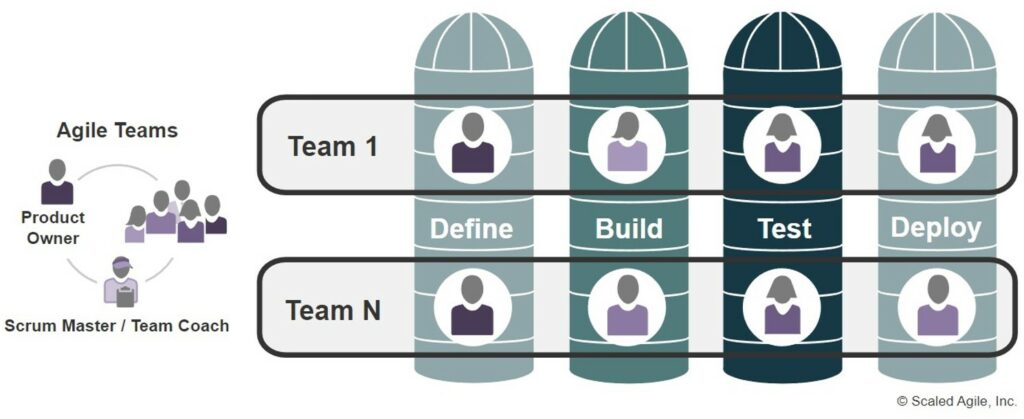
Essentially, agile teams collaborate within an ART to contribute, through their specialized efforts, to the achievement of the objectives of a Planning Interval (PI), a period of fixed duration that provides a regular cadence for planning, execution and reflection. In this way, by building agile teams, organizations can respond effectively to changing market demands, improve product quality and remain strongly focused on creating value for their customers.
Checklist
- Operational value stream (OVS): describes the sequence of activities required to deliver a product or service to a customer;
- Development value stream (DVS): describes the sequence of activities involved in developing and supporting the solutions used by OVS ;
- Agile Release Train (ART): describes a team of agile teams, each contributing to the construction and delivery of a part of a larger solution;
- Agile Team: describes a small cross-functional group of individuals, each with a role necessary to the realization of the product.
The canvas around value
It is therefore necessary to verify the existence of this structure within your organization implementing SAFe by the presence of specific canvas referencing your OVS, DVS, ART, Agile Teams, such as the Canvas below:
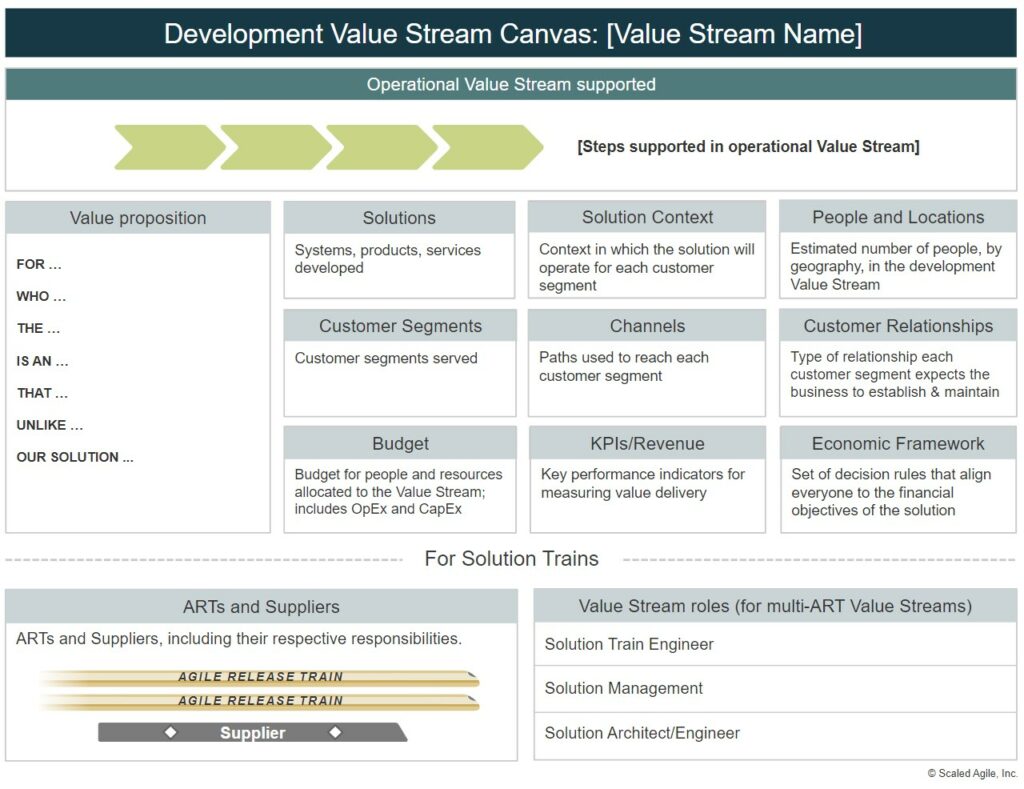
DVS and ART configuration reminder
It is also necessary to specify a point about the configuration of DVSs and ARTs, which can add complication to understanding the agility organization at scale. Several SVRs can be carried out by a single ART, or that one SVR can correspond to one ART, or that one SVR can require several ARTs, as represented below:
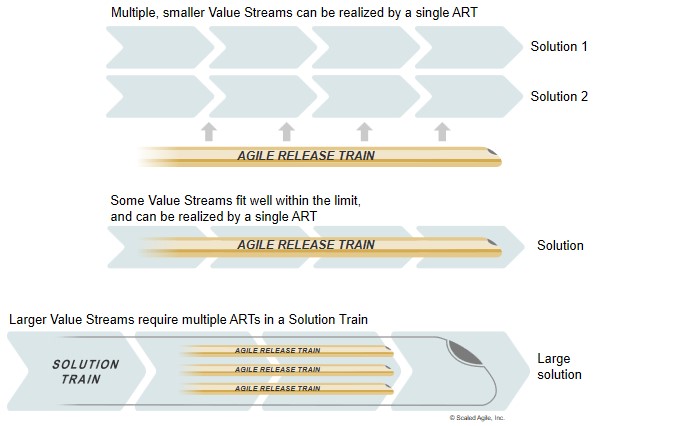
SAFe organization, in conclusion
In conclusion, by defining their OVS, DVS, ART and Agile teams, organizations can adopt the "organize around value" principle to improve their ability to remain user-centric, adapt to changing market conditions, and achieve better results by delivering the products and features that matter most to their customers. Indeed, this approach fosters agility, efficiency and innovation throughout the organization's value-creation process. Finally, do you respect this organizational structure of OVS, DVS, ART and Agile teams in your SAFe organization?
So don't hesitate to check out the official SAFe page, and our article on the importance of planning in this context of agility at scale. And don't forget to check out our agile expertise page: with four certified SAFe Practice Consultants (SPCs), we can support you in your transition to greater agility.
All visuals used here are the exclusive property of Scaled Agile, Inc.
